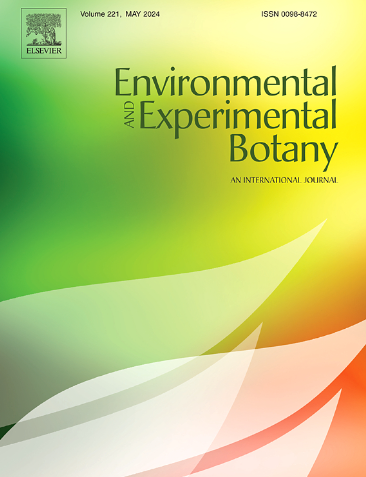群体感应信号(n -辛烷酰- dl -高丝氨酸内酯)调控杨树细根生长的转录组学和代谢组学分析
IF 4.7
2区 生物学
Q2 ENVIRONMENTAL SCIENCES
引用次数: 0
摘要
根微生物的跨界交流对植物与微生物的相互作用起着重要的主导作用。然而,细菌群落群体感应信号对根系生长发育的影响尚不清楚。以杨根际n -辛烷酰dl -高丝氨酸内酯(C8-HSL)为研究对象,研究了其对杨根的形态结构、超微结构和亚细胞结构的影响。通过转录组和代谢组测序进一步揭示C8-HSL调控根形态发育的潜在机制。结果表明,C8-HSL对杨树细根的生长具有双重调控作用。高浓度(≥100 μM)下,C8-HSL抑制杨树幼苗根系生长,主根和侧根变短变粗。相反,在低浓度(10 nM)下,C8-HSL促进根生长,主根和侧根伸长。荧光探针显示,当C8-HSL浓度大于1 μM时,根尖细胞内Ca2+ +、活性氧(ROS)和一氧化氮(NO)浓度显著上调,而当C8-HSL浓度小于1 μM时,只有Ca2+和NO浓度显著上调。转录组学和代谢组学分析进一步发现,高浓度C8-HSL显著上调杨树次生壁生物发生相关基因(如MYB46、MYB83、CESA)和生长素运输相关基因(如PIN6、AUX22B、GH3.6)的表达。低浓度C8-HSL上调钙调素表达,增加吲哚丙烯酸和3-吲哚丁酸含量。综上所述,这些发现为根与微生物之间的相互作用提供了更深入的了解,并暗示了群体感应信号在调节根生长方面的潜在利用。本文章由计算机程序翻译,如有差异,请以英文原文为准。
Transcriptomic and metabonomic analysis of quorum sensing signal (N-octanoyl-DL-homoserine lactone) on regulating poplar fine roots growth
Root-microbe transboundary communication is important to dominate the interaction between plant and microorganism. However, the influence of quorum sensing signals among bacteria community on the root growth and development is still obscure. The study focused on one quorum sensing signal isolated from poplar rhizosphere, N-octanoyl-DL-homoserine lactone (C8-HSL), and examined its influence on the morphological structure, ultrastructure, and subcellular structure of poplar roots. Transcriptome and metabolome sequencing were further performed to reveal the potential mechanisms of C8-HSL regulating the root morphological development. The results showed C8-HSL demonstrated dual regulatory effects on the growth of poplar fine roots. At high concentrations (more than 100 μM), root growth of poplar seedlings was suppressed by C8-HSL, and the primary and lateral roots appeared short and thick. Conversely, at low concentrations (10 nM), root growth was promoted by C8-HSL, and the primary and lateral roots were elongated. Fluorescent probes indicated that Ca2 + , reactive oxygen species (ROS), and nitric oxide (NO) in root tip cells were significantly up-regulated at concentrations more than 1 μM of C8-HSL, while only Ca2+ and NO concentration were significantly up-regulated at concentrations less than 1 μM of C8-HSL. Transcriptome and metabolome analysis further revealed that high concentration C8-HSL significantly upregulated the expression of poplar genes related to secondary wall biogenesis (e.g., MYB46, MYB83, CESA) and auxin transport (e.g., PIN6, AUX22B, GH3.6). In contrast, low concentration C8-HSL upregulated calmodulin expression and increased indoleacrylic acid and 3-indolebutyric acid content. Taken together, these findings provide a deeper insight to the interaction between root and microbes, and imply the potential utilization of quorum sensing signals in regulating root growth.
求助全文
通过发布文献求助,成功后即可免费获取论文全文。
去求助
来源期刊

Environmental and Experimental Botany
环境科学-环境科学
CiteScore
9.30
自引率
5.30%
发文量
342
审稿时长
26 days
期刊介绍:
Environmental and Experimental Botany (EEB) publishes research papers on the physical, chemical, biological, molecular mechanisms and processes involved in the responses of plants to their environment.
In addition to research papers, the journal includes review articles. Submission is in agreement with the Editors-in-Chief.
The Journal also publishes special issues which are built by invited guest editors and are related to the main themes of EEB.
The areas covered by the Journal include:
(1) Responses of plants to heavy metals and pollutants
(2) Plant/water interactions (salinity, drought, flooding)
(3) Responses of plants to radiations ranging from UV-B to infrared
(4) Plant/atmosphere relations (ozone, CO2 , temperature)
(5) Global change impacts on plant ecophysiology
(6) Biotic interactions involving environmental factors.
 求助内容:
求助内容: 应助结果提醒方式:
应助结果提醒方式:


